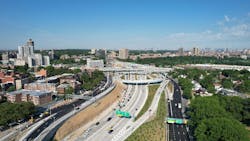By Roads & Bridges Editorial Staff
It’s that time of year again: We are accepting submissions to our annual Top 10 Roads and Bridges Awards.
We will reveal the projects that were chosen in the final issue of 2024, the November/December double issue.
Each entry is judged by our editorial staff. Tell us about the design of your project. Tell us what technology your team used and how that innovation aided the project. If you submit a rehabilitation project, tell us about the state of the road or bridge before work began. And, of course, tell us about challenges on the job site, and how your team overcame them.
We know we’re preaching to the choir. We receive so many great submissions that finalizing the list is difficult. It’s a lot of fun, too. And it’s an honor.
We wish we could celebrate every road and bridge project that is completed because the dedicated teams that design and build the country’s infrastructure deserve praise.
In that vein, here are some road and bridge projects from 2022 and 2023 that we loved and want to applaud. We hope that they inspire you to submit to the 2024 Top 10 Road and Bridge Awards.
Seward Highway MP 75-90
Alaska’s Seward Highway is listed as one of America’s Scenic Byways. However, a 15-mile stretch showed signs of fatigue, pavement raveling, and the bridge decks were nearing weight limits.
This rehabilitation project consisted of many components. That’s why the Alaska Department of Transportation and Public Facilities (DOT&PF) procured a team that included HDR, CRW Engineering Group, Granite Construction and Mass Excavation, Inc.
The statewide bridge group at DOT&PF led the bridge design, and HDR’s hydraulics and roadway design teams partnered closely with them.
The plan was to add five miles of passing and turning lanes through the narrow corridor. This strategy would realign multiple broken back curves into a single continuous curve.
Turning lanes were added at major intersections, and three pedestrian underpasses were built. This strategy is aimed at improving safety for motorists and pedestrians.
Jane Byrne Interchange
Rated as the worst freight bottleneck in the country by the Federal Highway Administration, Chicago’s Jane Byrne Interchange sees 400,000 vehicles per day with 25% of those vehicles being trucks.
This $800 million project was a massive undertaking for the Illinois Department of Transportation (IDOT), involving 19 bridges, approximately 50 retaining walls and over 32 miles of expressway.
IDOT employed the help of AECOM/TranSystems as the designer and several contractors including F.H. Paschen, Kiewit Construction, and McHugh Construction.
Tightly curved ramp bridges were implemented, and tight curved steel girder bridges were used for most of the ramps.
Nineteen new bridges were built for the project with seven of them being curved steel girder bridges.
There were over 50 stakeholder meetings to help determine the desired improvements to the interchange and surrounding neighborhoods.
The project was finished in October 2022. It is predicted that the Jane Byrne Interchange will reduce traffic delays by 50% by 2040.
Kew Gardens Interchange
New York’s Kew Gardens Interchange is one of the busiest and most complex in the country. Located in Queens, it sits at the crossroads of three major highways.
The New York State Department of Transportation (NYSDOT) hired H&H to design, and then cut the project into four phases to avoid impacts to existing roadways and structures while ensuring new construction would not harm future improvements and replacements.
The project included the design of 22 new or reconstructed bridges, numerous connecting ramps, and 15 lane-miles of roadway.
Completed in July 2022, the project provided long-term sustainability benefits like using materials designed to reduce maintenance life cycle cost, roadway drainage improvements, and reducing accidents in accident-prone locations.
North Tarrant Expressway – Segment 3C
The North Tarrant Expressway (Interstate 35W) in Fort Worth, Texas connects trade routes to Mexico and Canada. The Texas Department of Transportation (TxDOT) saw that the expressway needed to have its capacity expanded to keep up with increased growth and traffic in the region.
The first phase began in 2015 and was completed in
2018. The second phase started in 2019 with Segment 3C, a seven-mile stretch that included construction of four TEXpress (dynamic tolled) lanes, reconstruction of all main lanes and the addition of continuous frontage roads.
TxDOT employed Bowman Consulting, Louis Berger Group and North Tarrant Infrastructure (NTI) to take on the second phase.
This $910-million project required traffic coordination. With the corridor seeing 170,000 vehicles per day, major construction was scheduled overnight, and safety measures were put into place.
Safety was a top priority on the project. With the high traffic count and 5,300 workers on the project, the safety measures paid off with NTI recording zero life-threatening injuries or fatalities.
The team incorporated new technology on the project for an accurate and complete job hazard analysis (JHA). The technology moved NTI away from traditional paper JHAs by completing the assessment using a smart phone or tablet. With this new technol- ogy, the completion and accuracy rate of the JHA was at 94%.
The project was completed three months ahead of schedule in June 2023.
Madison Beltline Flex Lane
Wisconsin’s Madison Beltline is comprised of U.S. Highways 12, 14, 18 and 151. Sections of the beltline carry 130,000 vehicles per day, creating congestion and deteriorating infrastructure in Madison.
The Wisconsin Department of Transportation (WisDOT) selected a project team composed of Walbec, Rocco Crivello and HNTB to implement a shoulder lane and an asphalt overlay on the corridor.
The team increased the width of the inside median to accommodate a 10-foot Flex Lane and a buffer to the median barrier.
The existing median barrier was in poor condition and needed to be removed to accommodate the Flex Lane’s drainage improvements.
The Flex Lane allows drivers to use the inside shoulder as a driving lane with lane control signs displaying green arrows when drivers can use the lane. The Flex Lane is managed by WisDOT’s traffic management center through cameras, traffic sensors, and in-person inspections.
Bridge pier retrofits replaced the median barriers and protected the bridge piers with infill walls integral with the piers. This provided additional space for the Flex Lane and a short auxiliary lane was added to the Beltline.
The Madison Beltline’s Flex Lane was the first dynamic shoulder lane in Wisconsin. The team completed the project with on time and within budget.
West Mission Bay Bridge
Constructed in 1949, San Diego’s West Mission Bay Bridge connects the city’s famous beaches to its business districts.
Primary contractor Flatiron West replaced the existing four-lane bridge with two separate three-lane structures, providing an improved transportation link across the San Diego River for the 40,000 vehicles that cross each day.
The improvements included: Two new parallel bridge structures with three travel lanes in each direction; a class one bike path on each bridge and roadway widening and improvements along Sports Arena Boulevard, West Mission Bay Drive and the westbound Interstate-8 off-ramp, as well as fresh architectural features.
The new bridge incorporated a semi-circle or curved exterior girder and a non-uniform structure depth or parabolic shape to make the bottom of the bridge achieve, as quoted by the architect, “a stones skipping across water” design.
While this design is visually appealing, it required a significant amount of one-off customized formwork throughout the entire length of the bridge. From a field engineering perspective, creating a parabolic bridge with a 45-degree skew and a vertical curve was no easy feat.
Construction to the original bridge began in 2018 and concluded in April of 2023, resulting in two new iconic structures that were built to be long lasting with a 100-year service life.
Liberty Bridge
Bay City, Mich.’s Liberty Bridge spans 2,345 feet across the Saginaw River. Over the years, the double-leaf trunnion bascule bridge experienced multiple unplanned closures and needed significant repair.
Movable bridges are more expensive to build and maintain compared to fixed bridges, and the city could not afford the improvements needed to keep the bridges open, safe, and reliable, according to bridge owner United Bridge Partners (UBP).
Bay City hired Bay City Bridge Partners (BCBP), a local subsidiary of United Bridge Partners (UBP), to rehabilitate the span.
The design team developed a cost-effective design, and contractor Granite Kraemer added context specific enhancements, such as Lumenpulse lighting for the benefit of ships passing through the river.
Technology played a vital role in the project. The existing bridge had an antiquated control system that often led to electrical issues. The bridge’s electrical and control systems were replaced with equipment that includes remote monitoring and diagnostic capabilities.
A CCTV camera network was designed based on a 3D model of the span and was installed. The specialized and technical work began in December 2021 and the bridge reopened to traffic a year later.
Harkers Island Bridge
Steel reinforced bridges can corrode in coastal environments. Knowing this, the North Carolina Department of Transportation (NCDOT), primary contractor Balfour Beatty Infrastructure (BBI), and subcontractor National Erectors sought innovative techniques with the Harker’s Island Bridge Replacement project to avoid this problem.
The project includes a 3,200-foot-long fixed-span bridge to replace the existing Earl C. Memorial Bridge and Bridge No. 96, which connect the town of Straits to Harkers Island.
The new Harker’s Island Bridge is built over the straits to the east of the existing bridges and provides a direct path for drivers traveling to and from the mainland. With a 45-foot navigational clearance, the new bridge will allow boats to pass unimpeded and safely and motorists to travel without delays from bridge openings.
The project pioneers the use of carbon-fiber reinforced polymer (CFRP) strand in all prestressed structural elements in North Carolina. To eliminate steel reinforcement, NCDOT utilized fiber-reinforced polymer (FRP) materials in all the concrete components of the bridge.
The precast concrete piles and girders were reinforced with pre-stressed CFRP strands, and the cast-in-place footers, columns, caps and deck were reinforced with glass fiber reinforced polymer bars.
Site camera systems enabled the team to view, pan, and zoom from several locations on the project up to 60 feet in the air. Similarly, drone technology for scalable ortho-mosaic photos as well as progress videos and photos were also used at each abutment.
Construction has been ongoing since September 2021. The project is expected to be complete in the fall of 2025, with an in-water work moratorium that lasts from April 1 through Sept. 30 each year to protect fish spawning.
College Hill Bridge
Funded by a state legislative appropriation grant through the Florida Department of Transportation (FDOT), the College Hill Road Bridge project replaced a 535.5 foot, multi-culvert structure in Hardee County.
The design and construction of the project was started by Hardee County with FDOT oversight. When the project was more than halfway finished, designer Kimley-Horn was retained by the Hardee County Board of Commissioners to evaluate the College Hill Road Bridge over Payne Creek as well as assume the role of Engineer of Record (EOR) for the project.
Kimley-Horn divided the remaining work into two phases: The first phase was to evaluate the existing work performed and determine if it met FDOT or Florida Greenbook Standards as applicable. The second phase was to implement remedial design or design revisions to bring constructed work into conformity with the standards as required.
Asphalt was paved atop crushed shell base on the roadway. Chimney drains were added along the edge of each side of the road between culverts to prevent the accumulation of hydrostatic pressure within the roadbed.
After three years of working through challenges with the slowed supply chain, changes in crew, and alterations to original building plans, the project finished April 29, 2022. RB

